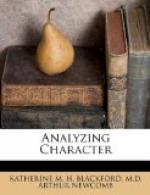Capacity for literature and expression is indicated by fulness of the eye, by heighth and width of the forehead, and, perhaps, especially by the development of the head and forehead at the sides just above the temples and back of the hair line. Any portrait gallery of great authors will show this development in nine out of ten (see figures).
The artistic, musical, or literary man with fine, silken hair, fine, delicate skin, small and finely chiselled features, and a general daintiness of build will express refinement, beauty, tender sentiments, and sensitiveness in his work, while the man with coarse, bushy or wavy hair, coarse, thick skin, large, rugged features, and a general ruggedness and clumsiness of build, even when his size is small, will express vigor, virility, ruggedness, and even gruesomeness and horror, in his work. There may be in his productions a wild, virile type of beauty, as in the music of Wagner and the sculpture of Rodin, but the keynote of his work is elemental force.
The dilettante has conical hands, with small, tapering fingers; this is the hand which is popularly supposed to accompany artistic temperament. He loves art. He appreciates art. He may even win fame and fortune as a competent critic of art, but he cannot create it. Your true artist has square, competent hands, with blunt, square-tipped fingers. The hands shown in figure 57 page 317 are those of a music lover who can neither play nor sing. Those in figure 58 are the hands of a true artist on the piano and pipe organ. The true producing artist nearly always has square hands, with large thumbs set near the wrist, thus giving a wide reach between tip of thumb and tip of forefinger, as shown in figure 58. Actors and operatic singers sometimes have conical hands, with tapering fingers. They express emotion and beauty with voice, gesture, and facial expression rather than with their hands.
In the world of art and literature many are called but few are chosen. The pathway to the heights is steep and rugged and there are many pitfalls. There are many by-paths. Furthermore, it is cold and lonesome on the mountain-top. Before anyone sets out on the perilous journey he should read Jack London’s “Martin Eden,” Louis M. Alcott’s autobiography, the story of Holman Hunt, the Autobiography of Benjamin Franklin, and the biographies of others who have attained fame in these fields.
CHAPTER X
WASTE OF TALENT IN THE PROFESSIONS
In the old days the physician was often a priest. There was mystery, magic, authority, and power in the profession. There were almost royal privileges, prerogatives, robes, insignia, and emoluments.
Humanity sheds its superstitions slowly. Science and common sense have smitten and shattered them for centuries, yet many fragments remain. And so there is still a good deal of mysticism, magic, and awe connected with both the art of healing and the priesthood. Hence, the lure of these professions. Romantic and ambitious youth longs to enter into the holy of holies, looks forward with trembling eagerness to the day when authority shall clothe him like a garment, when his simple-hearted people, gathered about him, will look up to him with adoration in eyes which say, “When you speak, God speaks.”




